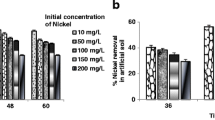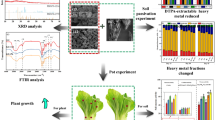Abstract
Heavy metals from leachate are persistent pollutants in soil, especially when landfills lack liners and basic structural system that prevents overflow of leachate beyond restricted areas. It is not ideal to rely only on physical and chemical options for the reclamation/restoration of such contaminated soil. Therefore, it is imperative to adopt bioremediation through the enhancement of microbial potentials. The present study investigated the use of individual isolates for the remediation of soil contaminated by leachate-metals. This is a way to understand the discrete potentials of the gram-positive bacteria species. Environmental isolates taken from contaminated soil were used to remedy soil characterized with various concentrations of metals (Al, Cd, Cr, Fe, Ni, Pb and Zn). Treatments A, B, and C amended with Bacillus sp., Lysinibacillus sp., and Rhodococcus sp., respectively, demonstrated better metal reduction potentials than the control experiment (Treatment D; zero microbial amendment) that depended solely on natural attenuation. With the exception of Ni, the degree of reduction of other metals was less than 50% for all treatments. This study suggests that such result reflects the potential ability of the microbes to metabolize selectively in the presence of metal pollution. However, it is difficult for the individual microbes to attain higher metal reduction efficiency (above 50%) except when blended in the appropriate formulation.



Similar content being viewed by others
References
Acosta JA, Jansena BK, Kalbitza A, Fazb S, Martínez M (2011) Salinity increases mobility of heavy metals in soils. Chemosphere 85(8):1318–1324
Agamuthu P, Fauziah SH (2010) Challenges and issues in moving towards sustainable landfilling in a transitory country-Malaysia. Waste Manag Res 29(1):13–19
Alkhafaji RA, Jianguo B, Jiangkun D, Zheng D, Luo Y (2014) Non-biodegradable landfill leachate treatment by combined process of agitation, coagulation, SBR and filtration. Waste Manag 34(2):439–447
Arjoon A, Ademola OO, Balakrishna P (2013) Enhanced 1,2-dichloroethane degradation in heavy metal co-contaminated wastewater undergoing biostimulation and bioaugmentation. Chemosphere 93(9):1826–1834
Chuan MC, Shu GY, Liu JC (1995) Solubility of heavy metals in a contaminated soil: effects of redox potential and pH. Water Air Soil Pollut 90(3–4):543–556
Delhaize E, Peter RR (1994) Aluminum toxicity and tolerance in plants. Plant Physiol 107:315–321
Emenike CU, Fauziah SH, Agamuthu P (2012) Characterization and toxicological evaluation of leachate from closed sanitary landfill. Waste Manag Res 30(9):888–897
Fauziah SH, Agamuthu P (2012) Trends in sustainable landfilling in Malaysia, a developing country. Waste Manag Res 30(7):656–663
Guo H, Luo S, Chen L, Xiao X, Xi Q, Wei W, Zheng G, Lui C, Wan Y, He Y (2010) Bioremediation of heavy metals by growing hyperaccumulaor endophytic bacterium Bacillus sp. L14. Bioresour Technol 101(22):8599–8605
Hseu ZY, Chen ZS, Tsai CC, Tsui CC, Cheng SF, Liu CL, Lin HT (2002) Digestion methods for total heavy metals in sediments and soils. Water Air Soil Pollut 141:189–205
Huang LD, Zeng GM, Jiang XY, Feng CL, Yu HY, Huang GH, Liu HI (2006) Bioremediation of Pb-contaminated soil by incubating with Phanerochaete chrysosporium and straw. J Hazard Mater 132(2–3):268–276
Huu HH, Swennen R, Cappuyns V, Vassilieva E, Gerven TV, Tran TV (2012) Potential release of selected trace elements (As, Cd, Cu, Mn, Pb and Zn) from sediments in Cam River-mouth (Vietnam) under influence of pH and oxidation. Sci Total Environ 435–436:487–498
Kasassi A, Rakimbei P, Karagiannidis A, Zabaniotoua A, Tsiouvaras K, Nastis A, Tzafeiropoulou K (2008) Soil contamination by heavy metals, measurements from a closed unlined landfill. Bioresour Technol 99(18):8578–8584
Kästner M, Breuer-Jammali M, Mahro B (1994) Enumeration and characterization of the soil microflora from hydrocarbon-contaminated soil sites able to mineralize polycyclic aromatic hydrocarbons (PAH). Appl Microbiol Biotechnol 41(2):267–273
Krishna MP, Varghese R, Babu AV, Jyothy S, Mohamed Hatha AA (2013) Bioremediation of zinc using Bacillus sp. isolated from metal contaminated industrial zone: prospects, bioscience: addressing the issues. Springer Link, London, pp 11–18
Lenart A, Katarzyna WK (2013) The effect of heavy metal concentration and soil pH on the abundance of selected microbial groups within Arcelor Mittal Poland steelworks in Cracow. Bull Environ Contam Toxicol 90(1):85–90
Leticia P, María PC, John S (2007) Effect of rapeseed oil on the degradation of polycyclic aromatic hydrocarbons in soil by Rhodococcus wratislaviensis. Int Biodeterior Biodegrad 59(2):111–118
Ludmila M, Bronislava U, Miroslav P, Jan N, Vladimír K (2009) Biodegradation potential of the genus Rhodococcus. Environ Int 35(1):162–177
Mora AP, Ortega-Calvo JJ, Gabrera F, Madejon E (2005) Changes in enzyme activities and microbial after “In situ” remediation of a heavy metal-contaminated soil. Appl Soil Ecol 28:125–137
Mrozik A, Piotrowska ZS (2010) Bioaugmentation as a strategy for cleaning up of soils contaminated with aromatic compounds. Microbiol Res 165(5):363–375
Muhaimin MDS, Mashitah MD (2013) Municipal solid waste management in Malaysia: current practices, challenges and prospect. Jurnal Teknologi 62(1):95–101
Navratilova J, Tvrzova L, Durnova E, Sproer C, Sedlacek I, Neca J, Nemec M (2005) Characterization of Rhodococcus wratislaviensis strain J3 that degrades 4-nitrocatechol and other nitroaromatic compounds. Antonie van Leeuwenhoek 87:149–153
Pansu M, Gautheyrou J (2006) Handbook of soil analysis: mineralogical, organic and inorganic methods. Springer, Berlin
Renoua S, Givaudan JG, Poulain S, Dirassouyan F, Moulin P (2008) Landfill leachate treatment: review and opportunity. J Hazard Mater 150(3):468–493
Sprocati AR, Alisi C, Tasso F, Marconi P, Sciullo A, Pinto V, Chiavarini S, Ubaldi C, Cremisini C (2012) Effectiveness of a microbial formula, as a bioaugmentation agent, tailored for bioremediation of diesel oil and heavy metal co-contaminated soil. Process Biochem 47:1649–1655
Tyagi M, Manuela MRF, Carla CCR (2010) Bioaugmentation and biostimulation strategies to improve the effectiveness of bioremediation processes, biodegradation. Springer Science, New York
Wang X, Jia M, Chen X, Xu Y, Lin X, Kao CM, Chen S (2014) Greenhouse gas emissions from landfill leachate treatment plants: a comparison of young and aged landfill. Waste Manag 24(7):1156–1164
Yamaguchi N, Nakamura T, Dong D, Takahashi Y, Amachi S, Makino T (2011) Arsenic release from flooded paddy soils is influenced by speciation, Eh, pH, and Iron dissolution. Chemosphere 83:925–932
Yang R, Tang J, Chen X, Hu S (2007) Effects of coexisting plant species on soil microbes and soil enzymes in metal lead contaminated soils. Appl Soil Ecol 37:240–246
Yuan BC, Li ZZ, Liu H, Gao M, Zhang YY (2007) Microbial biomass and activity in salt affected soils under arid conditions. Appl Soil Ecol 35:319–328
Acknowledgements
Authors would like to acknowledge Institute of Research Management and Monitoring, University of Malaya, Kuala Lumpur for the research grant provided (RP011A-14SUS). The role played by Dewan Bandaraya Kuala Lumpur (DBKL) Malaysia worth mention. This manuscript has no conflict of interest.
Author information
Authors and Affiliations
Corresponding author
Rights and permissions
About this article
Cite this article
Fauziah, S.H., Agamuthu, P., Hashim, R. et al. Assessing the bioaugmentation potentials of individual isolates from landfill on metal-polluted soil. Environ Earth Sci 76, 401 (2017). https://doi.org/10.1007/s12665-017-6739-x
Received:
Accepted:
Published:
DOI: https://doi.org/10.1007/s12665-017-6739-x




